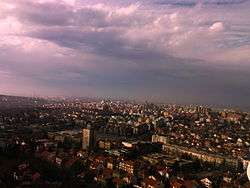Konjarnik
| Konjarnik | |
|---|---|
 | |
 Konjarnik | |
| Coordinates: 44°47′N 20°30′E / 44.783°N 20.500°E | |
| Country |
|
| Population (2002) | |
| • Total | 23,394 |
| Time zone | CET (UTC+1) |
| • Summer (DST) | CEST (UTC+2) |
Konjarnik (Serbian Cyrillic: Коњарник, pronounced [kɔ̌ɲaːrniːk]) is an urban neighborhood of Belgrade, the capital of Serbia. It is divided between Belgrade's municipalities of Voždovac and Zvezdara (roughly Konjarnik I, Konjarnik II and Konjarnik III, respectively). As a large neighborhood, it has several sub-neighborhoods of its own, including Denkova Bašta, Učiteljsko Naselje and Rudo.
Location
Konjarnik begins 4 km south-east of downtown Belgrade (Terazije) and itself stretched for over 2 km, mostly along Ustanička street, right side of the Highway Belgrade–Niš and between Ustanička and Vojislava Ilića streets. It borders the neighborhoods of Dušanovac on the west, Šumice on the south-west, Cvetkova Pijaca on the north, Mali Mokri Lug on the east, while the entire southern border of Konjarnik is marked by the highway which divides it from the neighborhoods of Medaković III and Marinkova Bara. Westernmost section of Konjarnik belongs to the municipality of Voždovac, the rest is in Zvezdara.
History
After World War I, part of the neighborhood of Cvetkova Pijaca was settled by the Kalmyks from the shores of the Caspian Sea, which fled Imperial Russia after the October Revolution in 1917. In Kozarčeva street, they built a Buddhist temple, a Mongolian-type pagoda in 1929, which was leveled to the ground in 1944, during German occupation of Belgrade. They had vast horse herds which were kept and left to graze in the open area which gradually became known as Konjarnik (literally, horse breeding area).[1] Building of a vast, modern neighborhood began in 1960s and continued in the 1970s, creating an urban connection between old Belgrade on the west and Mali Mokri Lug on the east. Population of Konjarnik by the 2002 census was 23,394.
Sub-neighborhoods
Konjarnik I
Westernmost section of Konjarnik, located in the municipality of Voždovac, between the streets of Ustanička on the north, Belgrade-Niš highway on the south and Vojislava Ilića on the east. It extends into the neighborhood of Dušanovac on the west and borders Šumice park on the north and Marinkova Bara on the south, across the highway. The area is, like the rest of Konjarnik, characterized by large, rectangular-shaped residential buildings. One of the major centers of Belgrade police, in Ljermontova street, is located in the neighborhood, and so is a new residential-commercial complex of KoŠum and a residential building Testera (Serbian for saw), because of its zig-zag construction. Green, forest belt separates the neighborhood from the highway.
Konjarnik II
Section of Konjarnik east of Vojislava Ilića street, with Ustanička as central street. Apart from many large residential buildings, it has an industrial zone, along the Vojislava Ilića and Mis Irbijeve streets (factories of "Precizna mehanika", "Bukulja", "Metal") and a developing . commercial zones along the roundabout of the "Lasta" bus lines on the crossroads of the Ustanička and Vojislava Ilića streets (including a Vero supermarket further away, etc.).
Konjarnik III
Part of Konjarnik north and east of the final section of Ustanička street. It has a commercial zones along the roundabout of the bus lines 17, 31 and trolleybus line 19. Two shopping malls, both named "Konjarnik" (old and new, one across another) are also located in Ustanička.
Učiteljsko Naselje
Učiteljsko Naselje (Учитељско насеље; "teachers' settlement") is located in the central part of Konjarnik II, centered on the Učiteljska street and the roundabout of the trolleybus line 21, just east of the industrial zone. Also location of the former Buddhist temple. Residential area, with a population of 9,516 by the 2002 census.
Učiteljsko naselje is located 3.5 km from Terazije square and just some meters down from Bulevar Kralja Aleksandra street. It's a pitty that is well known by adolescent hooligans and delinquents. Elementary school Ćirilo i Metodije is the famous building and the kids from neighbourhood go there in school. Main connection with center is trolleybus line 21. This is a central part of Zvezdara municipality, main street is Učiteljska. Učiteljsko naselje could be proud with many famous people living or lived there, folk-pop-dance singer Ivan Gavrilović, murdered opposition journalist Slavko Ćuruvija, actress Snežana Savić, former FK Partizan player and director Zoran Mirković, cult Serbian criminal Kristijan Golubović as well as others.
Denkova Bašta
Denkova Bašta (Денкова башта; "Denko's garden") is the latest addition to Konjarnik, ultra-modern city-within-city, built in the late 1990s and early 2000s, along the eastern side of the Vojislava Ilića street. It extends into Cvetkova pijaca on the north. Complex of several residential, step-like arranged circles of buildings.
Rudo
Rudo (Рудо) is a complex of three large buildings, each with 30 floors, over 100 meters in height and, therefore, share between themselves 4th place on list of tallest buildings in Belgrade and also in Serbia. Though officially styled Rudo (after a Bosnian town), the buildings are known as the Eastern Gate of Belgrade. All three buildings are step-like and triangular shaped, built in a circle so it always visually appears than one is between the other two. Buildings, styled Rudo 1, Rudo 2 and Rudo 3, were settled in 1976, but never fully completed, as the facade wasn't finished.[2] Since the 1990s, due to the lack of maintenance, buildings were known for elevator and water pumps problems. Reconstruction began in April 2008.
References
Coordinates: 44°47′N 20°30′E / 44.783°N 20.500°E
| Wikimedia Commons has media related to Konjarnik. |